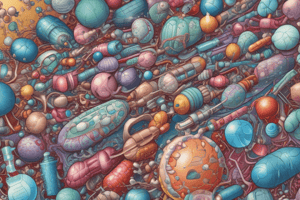Podcast
Questions and Answers
What is the primary reason why hydration of the skin is necessary for TDDS?
What is the primary reason why hydration of the skin is necessary for TDDS?
- To reversibly damage the stratum corneum and reduce its diffusional resistance
- To enhance the efficacy of chemical penetration enhancers
- To facilitate drug dissolution in the skin (correct)
- To increase skin absorption by denaturating lipids and lipoproteins
According to Fick's Law, what is the rate of drug transport across the skin directly proportional to?
According to Fick's Law, what is the rate of drug transport across the skin directly proportional to?
- Thickness of the stratum corneum (h)
- Molecular weight of the drug
- Surface area of the skin to which it is exposed (A) (correct)
- Viscosity of the formulation vehicle
What is the main difference between matrix-based and reservoir-based TDDS?
What is the main difference between matrix-based and reservoir-based TDDS?
- The composition of the formulation vehicle
- The mechanism of drug release (correct)
- The surface area of the skin to which it is exposed
- The type of drug used in the formulation
Which of the following is a characteristic of chemical penetration enhancers?
Which of the following is a characteristic of chemical penetration enhancers?
What is the purpose of a penetration enhancer in a TDDS?
What is the purpose of a penetration enhancer in a TDDS?
What is the effect of increasing the drug concentration in the formulation vehicle on the rate of drug transport across the skin?
What is the effect of increasing the drug concentration in the formulation vehicle on the rate of drug transport across the skin?
What is the main advantage of using a solid formulation in a TDDS?
What is the main advantage of using a solid formulation in a TDDS?
What is the purpose of using a matrix-based TDDS design?
What is the purpose of using a matrix-based TDDS design?
What is the effect of increasing the surface area of the skin to which a TDDS is exposed on the rate of drug transport?
What is the effect of increasing the surface area of the skin to which a TDDS is exposed on the rate of drug transport?
What is the purpose of using a reservoir-based TDDS design?
What is the purpose of using a reservoir-based TDDS design?
Flashcards are hidden until you start studying
Study Notes
Immediate and Controlled Release
- Immediate release: needles dissolve, providing an immediate effect
- Controlled release: depends on the polymer used, providing a sustained effect
Design of TDDS
- Basic components:
- Outer backing film: occlusive, water-resistant, and drug-impermeable, with a low moisture vapor transmission rate
- Thickness: 2-3 mm, transparent or pigmented film, usually beige
- Materials: polypropylene, polyethylene, polyolefin
- Drug is dispersed or dissolved in an inert polymeric matrix, providing support and control for drug release
- Rate-controlling membranes (in reservoir design only)
- Adhesive layer: sticks the patch to the skin, e.g. polybutyl acrylate
Matrix (Monolithic) TDDS
- Polymer used is usually solid
- Increases hydration of skin due to sweating, increasing skin absorption
- Skin hydration is essential for drug dissolution, but creams or moisturizers should be avoided as they increase hydration excessively
Kinetics of Transdermal Diffusion
- Follows Fick's Law: dQ/dt= DAK (Cvehicle– CP) / h
- Rate of drug transport across the skin is directly proportional to:
- Drug oil/water partition coefficient (K)
- Drug concentration in the formulation vehicle (Cvehicle)
- Surface area of the skin (A)
- Rate of drug transport is inversely proportional to the thickness of SC (h)
Formulation Factors
- TDDS design: Matrix vs. Reservoir
- Drug formulation: Solid vs. Liquid, with solid providing faster absorption
- Penetration enhancers:
- Chemical Enhancers (Passive): reversibly damage or alter the stratum corneum to reduce diffusional resistance, e.g. acetone, ethanol, PEG, PG, azone, DMSO
- Selection based on efficacy, toxicity, compatibility
Studying That Suits You
Use AI to generate personalized quizzes and flashcards to suit your learning preferences.




